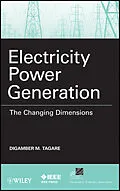This book offers an analytical overview of established
electric generation processes, along with the present status &
improvements for meeting the strains of reconstruction. These old
methods are hydro-electric, thermal & nuclear power
production. The book covers climatic constraints; their
affects and how they are shaping thermal production. The
book also covers the main renewable energy sources,
wind and PV cells and the hybrids arising out of these.
It covers distributed generation which already has a large presence
is now being joined by wind & PV energies. It covers their
accommodation in the present system. It introduces energy stores
for electricity; when they burst upon the scene in full strength
are expected to revolutionize electricity production. In all the
subjects covered, there are references to power marketing & how
it is shaping production. There will also be a reference
chapter on how the power market works.
Autorentext
Digamber M. Tagare is founder and Managing Director of Madhav
Capacitors Pvt. Ltd. He is responsible for bringing capacitor
manufacturing technology to India, and was awarded with the title
of "Father of Capacitor Industries in India" from Indian Electrical
and Electronics Manufacturers Association (IEEMA) in 2002. Mr.
Tagare has published more than 100 technical papers and four books
on capacitors and reactive power management. He is a member of both
the National Association of Corrosion Engineers and the Electrical
Research Association, as well as a Senior Life Member of the
IEEE.
Zusammenfassung
This book offers an analytical overview of established electric generation processes, along with the present status & improvements for meeting the strains of reconstruction. These old methods are hydro-electric, thermal & nuclear power production. The book covers climatic constraints; their affects and how they are shaping thermal production. The book also covers the main renewable energy sources, wind and PV cells and the hybrids arising out of these. It covers distributed generation which already has a large presence is now being joined by wind & PV energies. It covers their accommodation in the present system. It introduces energy stores for electricity; when they burst upon the scene in full strength are expected to revolutionize electricity production. In all the subjects covered, there are references to power marketing & how it is shaping production. There will also be a reference chapter on how the power market works.
Inhalt
Foreword xxi
Preface xxv
1. Electricity HistoryA Review of the Road Ahead 1
1.1 History of Growth of the Electricity Business 1
1.2 Innovative Technology Developments and Growth of Conglomerates 2
1.3 Economic GrowthGDP and Electricity Consumption 3
1.4 Monopolies Develop Built-In Defects 4
1.5 Breakup of Bell Systems Leads to Unbundling 5
1.6 Importance of Renewable Energy RecognizedWind Energy Becomes a Challenger 7
1.7 Structural Changes 8
1.8 Cost Breakdown in the Old Model 10
1.9 Step-by-Step Restructuring 11
1.10 The New Decision Authorities 12
1.11 Open Power Marketing Now Rerestructuring Electricity Power System 13
References 13
2. Risks, Operation, and Maintenance of Hydroelectric Generators 15
2.1 The Present Scenario 15
2.2 Types and Sizes of Hydroelectricity Projects 15
2.3 Advantages of Hydroelectricity 18
2.4 Slow progress of Hydroelectricity Projects 19
2.5 Factors Propelling the Phased Progress of the Hydroelectric Industry 21
2.6 Hydro Projects Fall Short of Attracting Private Investment 22
2.7 Dam Building Progress Over a Century 22
2.8 Desirable Configuration for Hydro Projects to Attract Private Investment 24
2.9 Operation of a Hydroelectric Plant 25
2.10 Unit Allocation within a Large HE Plant 28
2.11 Speed Control of a Water Turbine 28
2.12 Startup Process for a WTG 29
2.13 Speed Controls are Rigid 30
2.14 Speed Increase Due to Sudden Load Cutoff 30
2.15 Frequency and Harmonic Behavior After a Sudden Load Rejection 30
2.16 Effect of Penstock Pressure Pulsations 33
2.17 AC Excitation of Rotor Field 33
2.18 Unit Commitment from Hydroelectric Generators, Including Pumped Storage Systems 34
2.19 ICMMS of Hydroelectric Generating Units 34
2.20 Controls and Communications in hydro Systems 35
2.21 General Maintenance 35
2.22 Limitations of Scheduled and Breakdown Maintenance 36
2.23 Reactive MaintenanceKey Elements 36
2.24 Key Components of an ICMMSCase of a Hydroelectric System 37
2.25 Intelligent Electrohydraulic Servomechanism 37
2.26 Online Monitoring and Forecasting 38
2.27 Subsynchronous Resonance (SSR) and Twisting of Rotor Shafts 39
References 40
3. Hydroelectric GenerationPumped Storage, Minor Hydroelectric, and Oceanic-Based Systems 45
3.1 Water as an Energy Supplier and an Energy Store 45
3.2 Pumped Water Storage System for Electricity Generation 46
3.3 Operation of a Pumped Storage System 46
3.4 Pumped Storage Systems Have Limited Scope 47
3.5 Pumped Storage Systems and Wind Energy 48
3.6 Small Hydroelectric Plants (SHPs) 49
3.7 Types of SHP ProjectsSizes 49
3.8 Location-Wise Designations of SHPs 50
3.9 Components of an SHP 50
3.10 Typical Layouts of SHPs 51
3.11 Project Costs of an SHP 54
3.12 Drawing Electricity from the Ocean 55
3.13 Underwater Turbine and Column-Mounted Generator 57
3.14 Wave Energy 58
Appendix 3-1 World's Largest Hydro-Electric Projects 60
Appendix 3-2 Remote Control of the Hydroelectric System at Guri 61
References 67
4. Thermal Power GenerationSteam Generators 69
4.1 Thermal Electricity Generation Has the Largest ShareThe Present Scenario 69
4.2 Planning of Thermal StationsRisks and Challenges 70
4.3 Cost Breakdown and Consumption Pattern of Electricity 71
4.5 Workings of a Coal-Fired Steam Generator Unit 74
4.6 Types of Boilers 76
4.7 Classification of Generating Units 78
4.8 Combined-Cycle Power Plant (CCPP) 79
References 83
5. Thermal Station Power Engineering 87
5.1 Start-Up Process of a CCPP 87
5.2 Short-Term Dynamic Response of a CCPP to Frequency Variation ...
